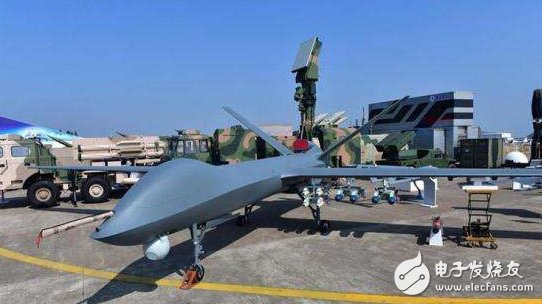A propeller aircraft with a wingspan of more than 40 meters and covered with solar panels was quietly parked in the hangar of the China Aerospace Aerodynamics Research Institute. The Rainbow series of solar drones have completed flight tests and will test near-space altitudes this year. Shi Wen, chief engineer of the Aerodynamics Research Institute UAV, said that this is the world's largest solar drone after the NASA series in the United States. Its performance indicators and technical capabilities are the top three in the world.
With the three "magic weapons" of super high altitude, long navigation time and easy protection, solar drones are expected to undertake long-term airborne early warning, large-scale aerial reconnaissance and disaster monitoring, meteorological observation, and communication relay.

Solar drones typically use large aspect ratio wings and can be raised to a height of 20 to 30 kilometers. This airspace is thin and the weather conditions are stable, so the flight can be smoother and faster.
The aspect ratio is the square of the length of the wing divided by the area of ​​the wing. Modern large aircraft often use large aspect ratio wings to reduce energy consumption. In the same solar-powered aircraft, the higher the flying height, the greater the power required, and the higher the requirements for photovoltaic absorption and propulsion system efficiency, the structure of the body and the weight of the battery pack.
Shi Wen said that the aerodynamic layout and airfoil of the solar drone can not be applied to the mature conventional aircraft template. The key is to solve the aerodynamic layout optimization design problem to improve the lift-to-drag ratio of the aircraft.
He said that due to the power flight provided by solar energy, the current 60-meter solar-powered drone provides a payload capacity of roughly 50 kilograms.
In contrast, the Swiss "Sunshine Power 2" solar-powered aircraft that completes the global flight requires a total load of approximately 100 kg and a design cruising range of 1.5 km to 8.5 km due to the need to carry personnel and related equipment. The flight is subject to meteorological conditions. Greater impact.
Flying for a long time, the goal is to keep flying for several months.Solar drones have no fuel consumption and are expected to fly for long periods of time, months or more.
In 2009, the US Department of Defense's Pre-research Institute launched the "Vulture" program to develop a payload that can maintain a height of 18.3 km to 27.4 km, carry a 450 kg payload, last for more than 5 years, and can be 99%. Fixed-wing aircraft maintained in the mission airspace for a sustained period of intelligence, surveillance, reconnaissance and communications relay capabilities. Solar drones have become the first choice for their plans.
“Sunshine Power 2†has reached a maximum of 118 hours of uninterrupted flight during the 2015-2016 global flight.
According to Shi Wen, due to the lack of energy-to-weight ratio of solar cell conversion efficiency and energy storage battery, the current flight capacity of solar drones is generally from 150 km/h to 200 km/h.
He said that high-efficiency, high-energy-density solar energy and energy storage energy systems are key areas for determining the performance level of solar drones, so a lot of attention needs to be paid to emerging technologies, including ultra-efficient flexible thin-film solar cells and lightweight array technology, and advanced photoelectric conversion technology. , high specific energy storage battery technology.
Easy to protect, provided that the system technology is highly reliableSolar drones have a high operating cost ratio. The airborne system is simple, the length of the runway is not high, and there is no need for fueling and other support equipment. Due to the long flight time, there is no need to change the rotation frequently to complete a permanent mission.
However, Shi Wen told reporters that the overall design technology of solar drones has not yet formed a mature design system at home and abroad, and the technical and engineering design is also different from the conventional fixed-wing drones.
For example, the performance requirements of the adjacent space flight environment for the motor device are both high efficiency, high power density, high reliability, and high stability. The sensors and actuators of the existing aviation platform flight control system are also unable to meet the ultra long-term flight time. Such requirements require a large number of design tests and actual flight verification.
However, compared with satellites, solar drones have the advantages of low cost and flexible deployment. In addition, it can be combined with high-altitude giant airships to form an uninterrupted situational awareness, communication and relay network with full coverage of the area with the combination of fixed platform and mobile platform.
Shi Wen said that the research team he led has initially explored the key technical points of solar aircraft, and future research will advance to a higher level of difficulty and deeper.
APM ac power source model SP300VAC1500W provides a complete AC test solution with built in arbitrary waveform generator to simulate many types of power waveforms, at power levels up to 1500 VA.With better accuracy and faster response time, The dc and ac output power supply offers greater advantage for R&D and compliance tests.The application is from bench-top testing to mass production.
This AC source model SP300VAC1000W adopts high speed DSP+CPLD control, high frequency PWM power technology and active PFC design to realize AC/DC stable output.
Some features as below:
- 4.3"large touch color screen
- AC+DC mixed or independent output mode
- Capable of setting output slope/phase angle
- Built-in IEC standard test function
- Built-in multiple protections
- Built-in power meter
- Support impedance function
- Support for LIST/PULSE/STEP mode & Transient mode
- Standard RS232/RS485/USB, Optional GPIB//LAN
- Support harmonics/inter-harmonics simulation and measuring function
- Support for USB data import/export and scree nap from front panel
1500W AC Power Supply,Adjustable 1500W Power Supply,1500W Power Supply,Ac Dc Power Source
APM Technologies Ltd , https://www.apmpowersupply.com
